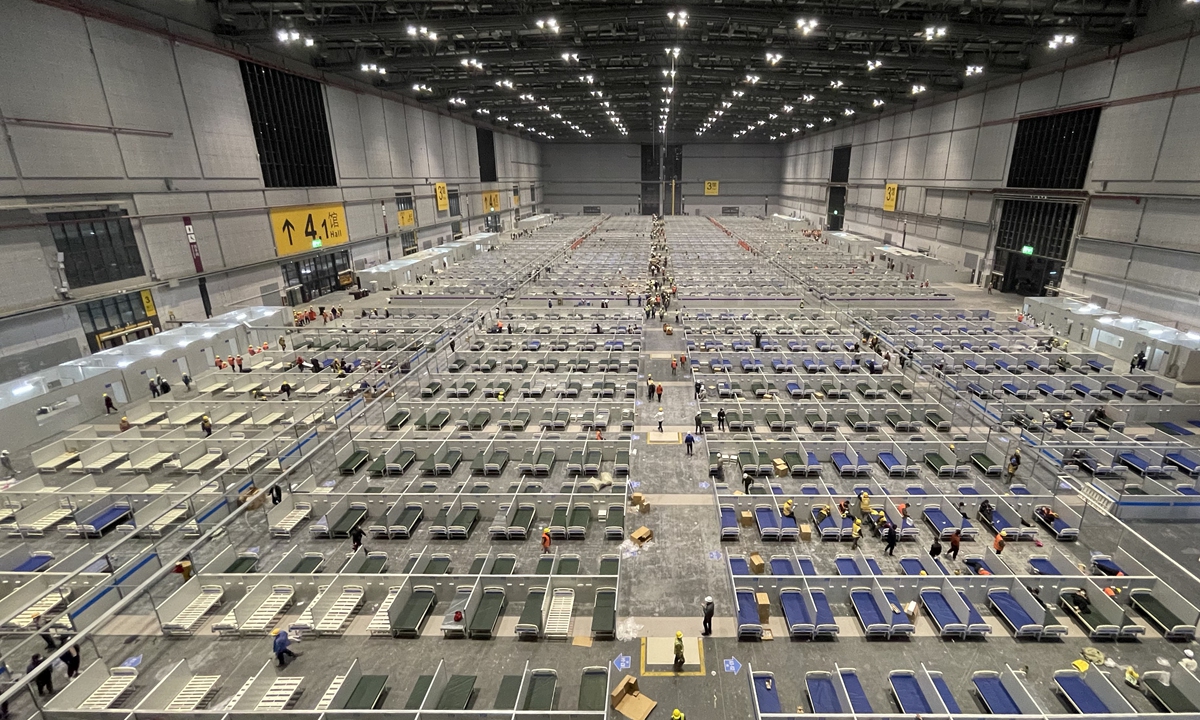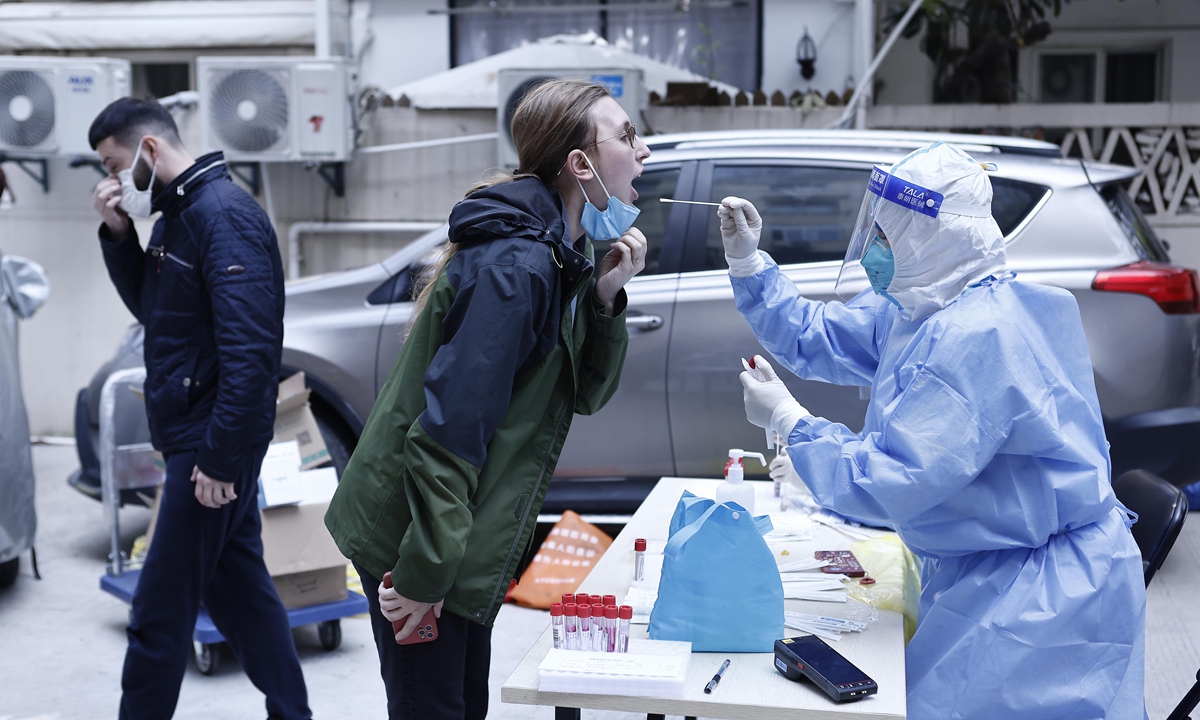
The largest makeshift hospital in Shanghai, renovated from National Convention & Exhibition Center (Shanghai), will be delivered on April 9, 2022 and is expected to provide up to 50,000 beds. Photo: Xinhua
Shanghai inaugurated its largest makeshift hospital on Saturday amid heightened efforts in battling Omicron, as new daily infections continued to climb. Amid current decisive and effective epidemic control measures, a research team forecast that the epidemic in Shanghai will soon start to ebb and may come to an end in early May.
Shanghai reported 1,015 confirmed and 22,609 asymptomatic domestically transmitted COVID-19 cases on Saturday, a new record. The city has reported about a total of 150,000 infections since March 1.
Shanghai's largest makeshift hospital, which can provide more than 50,000 beds, was delivered around Saturday noon, and the first batch of patients has been transferred there.
Chinese Vice Premier Sun Chunlan on Saturday urged strict moves to implement epidemic control measures, and everything possible to ensure transportation and supply chains in Shanghai.
Sun said the city must break logistics and distribution bottlenecks as soon as possible, and let more supply-guaranteed enterprises and personnel return to work in a bid to stabilize both supply and industrial chains.
She inspected the largest makeshift hospital on Saturday and reviewed hospitalization procedures for patients. She called on management and medical teams at the hospital to facilitate admission procedures and enhance management.
Sun also visited vegetables storage sites in Pudong on Saturday, urging improvement to the delivery process, underlining that goods should be delivered directly to households.
In total, Shanghai had built more than 100 makeshift hospitals with more than 160,000 beds. There are also eight designated hospitals with around 8,000 bed capacity, officials revealed at the Saturday press conference.
Shanghai remains in full throttle in fighting against the epidemic. It has already conducted several rounds of nucleic acid or antigen testing since March 1. From April 4 to 8, the city has tested more than 95 million samples with a total of 94,400 positive results, municipality officials revealed at the Saturday press conference.
Shanghai deputy mayor Zong Ming choked up sobbing at a press conference on Saturday when vowing to improve anti-epidemic work after receiving complaints from residents in the city. "We have not done enough. There is still a big gap from everyone's expectations. We will do our best to improve it," she said.
Zong said that Shanghai is facing the most vital moment in combating the epidemic. She said that strict measures would remain in place to curb viral transmission and realize zero COVID-19 case as soon as possible.
In order to solve the problem in goods supply to residents, Gu Jun, an official from Shanghai business commission, revealed more measures at the press conference.
A cross-provincial coordination mechanism has been set up to transfer daily supplies from neighboring cities. Three transfer stations in Kunshan in Jiangsu, Pinghu in Zhejiang, and Shanghai had been put into use.
In order to make sure the daily necessities will be delivered to residents, nine additional e-commerce storage facilities and 17 supermarkets were reopened on Friday, with 1,096 additional local personnel and 2,000 people from other cities have been deployed since Friday, according to Gu.
The city also kicked off a new round of nucleic acid and antigen testing on Saturday.

A foreign resident in Shanghai gets her sample taken for nucleic acid testing on April 6, 2022. Photo: cnsphoto
Medical workers from across the country, including those from the military, have been deployed to support the city,
mirroring efforts taken in Wuhan in early 2020.
The latest prediction from a Lanzhou-based research team served to boost the public confidence in Shanghai's fight against the virus.
Starting from March 1, new cases in Shanghai kept climbing until April 9, on which the epidemic would start to decline , a research team from the collaborative innovation center of western ecological safety affiliated with Lanzhou University, led by Huang Jianping, told the Global Times on Saturday.
Based on the timely and effective efforts at present taken by the municipal government, the team predicts that this current outbreak in Shanghai will end around May 2 with a total of 293,720 infections.
Specifically, new daily infections in Shanghai would decline to under 1,000 by April 20, under 100 on April 24 and under 10 on April 27, according to the team.
Zhang Wenhong, head of the Center for Infectious Diseases with the Huashan Hospital of Fudan University in Shanghai, and member of the Shanghai COVID-19 treatment expert group, told local media outlet thepaper.cn that the battle against Omicron is a big jigsaw, which included not only medical treatment, but also the public's access to essential goods and services under the weight of the epidemic.
The current Omicron wave was sudden, sneaky and spreading fast, causing a huge strike to the community. To realize dynamic-zero COVID-19, complete the jigsaw and solve problems of maintaining living standards, it requires the participation of more forces from across society, Zhang noted.
Zhang said that the city must make full preparations for potential outbreaks in the future, including booster shots for the seniors, medical supplies, nucleic acid testing capacity, the construction of quarantine centers and the establishment of the system of tiered diagnosis and treatment.
Without a strong anti-epidemic mechanism, even if we can realize dynamic-zero COVID-19 case, more problems would occur in future outbreaks, Zhang noted.
Almost no young, vaccinated people have presented severe symptoms, however, older people especially those with chronic diseases and not vaccinated, still face heightened risk, according to Zhang.
"Omicron is not a big flu, it bites people, especially those older people who have not been vaccinated," Zhang said.
China's method to protect this group is to implement dynamic-zero COVID-19 strategy and encourage the elderly to receive booster shots, Zhang noted.





